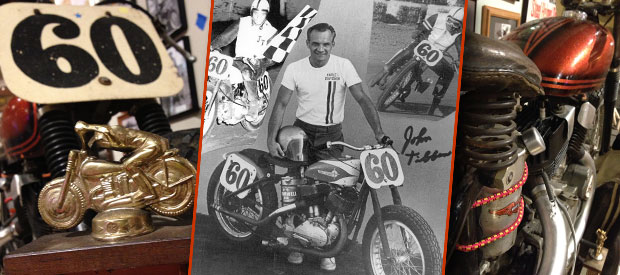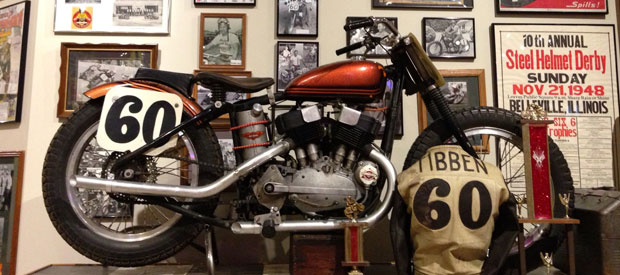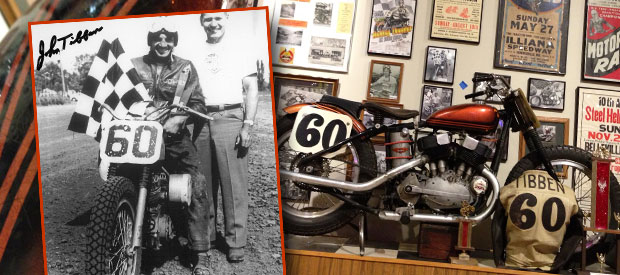
The National Motorcycle Museum will be installing a new one year temporary exhibit, Allstate Motorcycle Dirt Track Heroes, to open May 18 with a dedication during Vintage Rally 2013, June 8 & 9, 2013. Among almost 30 great dirt track racers is a 1954 Harley-Davidson KR750 that stands out. Why? Two reasons: It’s one of a few old race bikes that still looks as it did when last raced, nothing is repainted or restored. And that original paint is very “period” for this KR being metal flake burnt orange! Second, that bike has been a lot of places and won a lot of races, has stories to tell. Motorcycle racing journalist Larry Lawrence spoke with John Tibben, the KR’s builder, tuner and rider, to get his story. If you’d also like to listen to Larry Lawrence’s live, unedited 100 minute interview with John Tibben, go to: http://archive.org/
In addition to Tibben’s #60 Harley-Davidson KR750, on display at the Dirt Track Heroes exhibit are John’s racing leathers, his racing and shop tool boxes and even the same wood support block he used in the pits for many years. See it all in person while Dirt Track Heroes is at the National Motorcycle Museum, Anamosa, Iowa.
Cycle News Archive
The Hawkeye Hauler
By Larry Lawrence
Wayne Rainey, Sammy Sweet, Chuck Joyner, Ed Varnes and Dan Stanley are just a few of the AMA Grand National riders to sport national number 60 throughout the years, but the original No. 60, the rider who wore the plate from the 1950s through to 1970 was Iowa’s own John Tibben. Tibben emerged from the earliest days of Iowa’s scrambles circuit to become one of the leading up-and-coming racers of the late 1950s. While he never won a national in his years of pro racing, he was a consistent top-10 finisher in the top echelon of racing in America. He earned the bulk of his victories and earnings in smaller regional races at state and county fairgrounds tracks across the Midwest. He was also a long-time regular in the heyday of Chicagoland’s famous Santa Fe Speedway and its Wednesday night racing program.
Clint Eastwood’s Dirty Harry character once famously said, “A man’s got to know his limitations.” Tibben reflected that same attitude when it came to reminiscing about racing the nationals in the late 1950s and ‘60s.
“To line up with Dick Mann, Carroll Resweber, Joe Leonard and Dick Klamfoth… well you just about knew you were racing for fifth,” Tibben chuckles. “There was no sense in wrecking, or making a scene, because that’s just the way it’s going to be.”
Tibben grew up on a small farm near Victor, Iowa. His first motorbike was a Whizzer that he rode to school with his sister on the back in the late 1940s. As a boy he was a fan of sprint car racing that was so popular in that part of the country. Tibben was on the path to becoming a car racer, something he would do later in life, but as a young man he was already a motorcyclist, having graduated from the Whizzer to a Harley 45 by his late teens. A couple of local Harley-Davidson dealers were all too happy to help Tibben get into racing two wheels so that’s what he did.
He started out in scrambles, a sport that would eventually evolve into motocross, but was something quite different in mid-1950s Iowa. Tibben vividly remembers what scrambles events were like 60 years ago.
“Most of the scrambles tracks in Iowa where in front of a grandstands at a fairgrounds,” Tibben explains. “Vinton, Iowa, had a quarter-mile oval and you’d start out at the start-finish line, just like any race, and you’d go through the first turn and then make a sharp right and go off the racetrack and down through the tullies, out around behind the backstretch and then come back on the oval in turn three and that was it, you’d make another lap. It’s was very much like TT racing except that the track were not as well prepared and sometimes barely wide enough for two bikes.”

Shortly after his scrambles debut Tibben began flat track racing. In 1957 Tibben moved to the big city – Chicago – to pursue his racing career. Tibbenpointed out the advantages of being based in Chicago. “It was centrally located for racing,” he said. “All around Illinois, Indiana, Michigan and Wisconsin you had your pick of events to run. And then you had Wednesday nights at Santa Fe Speedway.”
Santa Fe Speedway was the legendary track that had a 40-plus year run of hosting a weekly motorcycle program. With a regular paying race, Santa Fe attracted a lot of riders from across the country to base out of Chicago – riders like Darrel Dovel, Fred Nix and Gary Nixon. Tibben took a job in a motorcycle shop and his life was fully immersed in racing. By 1958 he earned his national number. His friendly personality earned him a lot of friends on and off the track. In 1960 he finished fifth in the annual AMA’s Most Popular Rider voting, behind only Carroll Resweber, Dick Klamfoth, Sammy Tanner and Dick Mann.
Like many riders of the era, running the nationals was not a priority. “I ran them if they were close and worked in my schedule,” Tibben said. Instead Tibbenfocused on the smaller regional races. “Winning a big race or a small race, it didn’t matter, it still felt good. The main thing in those days was finishing in the top four so you were in the money. It paid $110 to win at Santa Fe Park and that’s when most people were making about $75 per week. So it wasn’t too bad to be a racer in those days. You were making more than anybody working in a factory all week.”
Still Tibben had the talent to run up front in the nationals. Riding his beloved Harley KR, he scored top-10 finishes in the Daytona 200 three out of four years in the early 1960s, with a seventh on the beach course on 1960 his best result. “One time I came home from Daytona with $600 and I was really in business!” He also earned top tens in some of other big races of the era, including races like the Charity Newsies in Columbus, Ohio, and the Springfield Mile. And it wasn’t just on the dirt where Tibben proved his skills. In the road race national at Carpentersville, Illinois, in 1964, Tibben copped yet another top-10 finish.

For the most part Tibben stuck around the Midwest, but in ’65 he went out west at the end of the season to do some West Coast nationals and all winter he ran races out there, including Ascot. “You didn’t realize it, but before you knew it at Ascot you were going so fast that if something happened it would be pretty bad,” Tibben said of the track that was legendary for making heroes as well as ending careers.
It was also in ’65 where Tibben scored his best national result. The AMA series came to his home track at Santa Fe Speedway in August of that year for a Short Track National. Tibben took fourth that night, just behind Nixon, Ronnie Rall and George Roeder. He was ahead of some of the stars of the sport like Bart Markel, Mert Lawwill and Eddie Mulder.
Just about every rider got hurt racing in those days Tibben says. During his career he had four big crashes that resulted in him missing two or three months of racing at a time. “Fortunately I was knocked unconscious every time,” he said. “That was the best painkiller in those days.”
By the early 1970s Tibben wound down his racing schedule and moved back to Iowa to start what would become a thriving aviation business. In 20 years of racing Tibben said he raced in over 1000 meets and won between 350 and 400 races. Over the years he collected a lot of old race bikes and one of his machines are on display at the National Motorcycle Museum in Anamosa, Iowa. He also has a home workshop/garage with bikes and cars that’s nearly a museum in itself. He still attends races on occasion today and marvels at skills of the riders today.

Pages
- 13th Annual East Central Iowa Sidecar Rally
- 14th Annual East Central Iowa Sidecar Rally – Sept. 9, 2017
- 1909 Royal Pioneer
- 1912 Pierce Four
- 1914 Yale Twin
- 1923 Ner-A-Car Model A
- 1936 Harley-Davidson VLD
- 1939 Harley-Davidson EL "Piston Splitter"
- 1948 Indian Scout "Big Base"
- 1951 HD FL Cop Bike
- 1952 Vincent "Red" Rapide
- 1954 Harley-Davidson John Tibben's KR750 Dirt Track Racer
- 1955 Goggo 200 DeLuxe Scooter
- 1957 BSA Gold Star DBD34 Flat Tracker
- 1970 Vesco Engineering Yamaha Twin Streamliner
- 1977 Harley-Davidson XLCR
- 1990 XR1200 Jesse James Custom
- 2002 Winner
- 2003 Winner
- 2004 Winner
- 2005 Winner
- 2006 Winner
- 2007 Winner
- 2008 Winner
- 2009 Winner
- 2010 Winner
- 2011 Winner
- 2012 Motorcycle Cannonball
- 2012 Vintage Bike Show
- 2012 Vintage Rally
- 2012 Winner
- 2013 Vintage Rally
- 2013 Winner
- 2014 Winner
- 2015 Winner
- 2016 Winners
- 2017 Winners
- 2018 Winners
- 2019 Winners
- 2020 Winners
- 2021 Winners
- 2022 Winners
- About
- Allstate Motorcycle Insurance Quarter MileStones
- And the Winner is…
- Barn Find
- Baxter Cycle Annual Open House and Motorcycle Auction, August 20, 2016 – Saturday Only
- Bessie Stringfield, Southern Distance Rider
- Best of the Best Gallery
- Careers
- CHOPPER STORY and 2 WHEELS+MOTOR
- Closing out March, Women's (Motorcycling) History Month…
- COMING SOON
- Davenport AMCA Swap Meet 2012
- David E. Allison Memorial Ride – June 17, 2017
- Dirt Riding USA, presented by J&P Cycles
- Distinguished Gentlemans's Ride
- Donate to the National Motorcycle Museum
- Donations/Gifts
- Donnie Smith Bike & Car Show, St Paul, Minnesota, April 2-3, 2016
- Early American Transportation Innovation
- Featured Articles
- Featured Bike: 1972 Triumph X75 Hurricane
- Featured Bikes
- Featured Motorcycle: 1977 Triumph T140 Dirt Track Racer – Raced by Gary Scott
- Featured Motorcycle: The 1974 Ducati 750 Super Sport
- Featured Rider: Dick Klamfoth
- Featured Rider: Grand National Champion Jay Springsteen
- Featured Rider: John Tibben
- FTP Upload
- Harley-Davidson XR750 Cut away bike
- Home
- Honda Dream 50R
- HURRY – Time is Running Out to WIN This Motorcycle!
- International Motorcycle Show – Washington D.C. – Jan 6-8
- International Motorcycle Show – Cleveland, Ohio – Jan 27-29
- International Motorcycle Show – Dallas, Texas – Jan 13-15
- International Motorcycle Show – Minneapolis, Minnesota – Feb 3-5
- International Motorcycle Show, Chicago February 12-14, 2016
- International Motorcycle Show, Chicago, Illinois – Feb 10-12
- International Motorcycle Show, Minneapolis February 5-7, 2016
- Iron Invasion – October 1, 2016
- Iron Invasion – October 4, 2014
- J&P Cycles Iowa Rally 2017 – June 24-25
- Jay Springsteen's MX250 short track racer
- Job Requests
- Loan A Motorcycle
- Mama Tried Motorcycle Show, Milwaukee, Wisconsin February 19-21
- Mama Tried Motorcycle Show, Milwaukee, Wisconsin – Feb 17-19
- Mecum Las Vegas Motorcycle Auction – Jan 25-28
- Mecum Motorcycle Auction – June 1-3, 2017
- Midwest Hill Climbers 67th Annual Hill Climb – Sept. 10, 2017
- Motomice Author, Paul Owen Lewis Book Signing – July 1, 2017
- Motorcycle Cannonball Coast to Coast Endurance Run – Sept 5 – 21, 2014
- Motorcycle Cannonball Endurance Run – Sept 6 – 23, 2018
- Motorcycle Club Sponsorships
- Motorcycles
- Museum Guest Register
- Newsletter Sign up!
- Newsletter test page.
- ORGAN DONATION SAVED MY LIFE
- Parts Girl Promotions Motorcycle Swap Meet – March 5
- Parts Girl Promotions Swap Meet, March 6, SUNDAY ONLY!
- Pate Swap Meet, Fort Worth, Texas – April 27-30
- Previous Winners
- Progressive International Motorcycle Show – Chicago, IL – Feb 9-11, 2018
- Retro Rewind – January 10, 2015
- Retro Rewind – January 6, 2018
- Retro Rewind: Cars & Guitars – Jan 7
- Ride to Sturgis
- Rod & Custom Car Show, Monticello, Iowa – Feb 25-26
- Scooters!
- Sisters’ Centennial Motorcycle Ride – Here on July 11, 2016
- Stay Tuned for Our 2020 Fundraiser Bike
- Tall Corn Run Ride Event for Iowa Riders Announced
- test1234
- The "Barn Job"
- The 31ST Annual Dennis Kirk Donnie Smith Bike Show – March 24-25, 2018
- The Midwest Hillclimber's 66th Annual Hill Climb
- The Midwest Hillclimbers 67th Annual Motorcycle Hill Climb – June 4th
- Then Came Bronson
- Thunder Nites in Newton – July 14, 2017
- V-Twin EXPO by Easyriders – Jan 28-29
- V-Twin EXPO February 6-7, 2016
- Vintage Rally – June 10
- Vintage Rally – June 10, 2017 – Recap
- Vintage Rally – June 7 & 8, 2014
- Vintage Rally '13 Bike show results
- Vintage Rally June 20, 2015
- Vintage Rally June 4, 2016 Recap
- Vintage Rally Lodging
- Vintage Torque Fest April 29-30, 2016 Dubuque County Fairgrounds Dubuque, Iowa
- Volunteer
- Volunteer signup page
- Walneck's Swap Meet, Woodstock, Illinois – April 23
- Wauseon AMCA Swap Meet and Vintage Flat Track Races, July 15, 16 & 17 2016; Friday Through Sunday
- WIN This Classic 2015 Indian
- Win This Motorcycle!
- Wings & Wheels, An Amazing Donation to the National Motorcycle Museum
- Women & Long Distance Riding in America
- Get Involved!
- Event Calendar 2012
- Banquet Hall
- Links/Resources
- About Us
Categories
Archive
- August 2023
- July 2023
- June 2023
- May 2023
- April 2023
- March 2023
- February 2023
- January 2023
- December 2022
- November 2022
- October 2022
- September 2022
- August 2022
- July 2022
- June 2022
- May 2022
- April 2022
- March 2022
- February 2022
- January 2022
- December 2021
- November 2021
- October 2021
- September 2021
- August 2021
- July 2021
- June 2021
- May 2021
- April 2021
- March 2021
- February 2021
- January 2021
- December 2020
- November 2020
- October 2020
- September 2020
- August 2020
- July 2020
- June 2020
- May 2020
- April 2020
- March 2020
- February 2020
- January 2020
- December 2019
- November 2019
- October 2019
- September 2019
- August 2019
- July 2019
- June 2019
- May 2019
- April 2019
- March 2019
- February 2019
- January 2019
- December 2018
- November 2018
- October 2018
- September 2018
- August 2018
- July 2018
- June 2018
- May 2018
- April 2018
- March 2018
- February 2018
- January 2018
- December 2017
- November 2017
- October 2017
- September 2017
- August 2017
- July 2017
- June 2017
- May 2017
- April 2017
- March 2017
- February 2017
- January 2017
- December 2016
- November 2016
- October 2016
- September 2016
- August 2016
- July 2016
- June 2016
- May 2016
- April 2016
- March 2016
- February 2016
- January 2016
- December 2015
- November 2015
- August 2015
- July 2015
- June 2015
- May 2015
- April 2015
- February 2015
- January 2015
- December 2014
- November 2014
- October 2014
- September 2014
- August 2014
- July 2014
- June 2014
- April 2014
- March 2014
- February 2014
- January 2014
- December 2013
- November 2013
- September 2013
- August 2013
- July 2013
- June 2013
- March 2013
- October 2012
Leave a Reply
Want to join the discussion?Feel free to contribute!